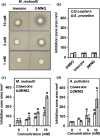Specialized naphthoquinones present in Impatiens glandulifera nectaries inhibit the growth of fungal nectar microbes
- PMID: 31245775
- PMCID: PMC6589542
- DOI: 10.1002/pld3.132
Specialized naphthoquinones present in Impatiens glandulifera nectaries inhibit the growth of fungal nectar microbes
Abstract
The invasion success of Impatiens glandulifera (Himalayan balsam) in certain parts of Europe and North America has been partially attributed to its ability to compete for bee pollinators with its rich nectar and due to its capacity to produce and release allelopathic 1,4-naphthoquinones (1,4-NQs) from its roots and leaves. Given that other 1,4-NQs present in the digestive fluids of certain carnivorous plants are proposed to control microbial colonization, we investigated the potential for the 1,4-NQs, 2-methoxy-1,4-naphthoquinone (2-MNQ) and lawsone, to fulfill an analogous role in the nectaries of I. glandulifera. Both 2-MNQ and lawsone were detected in the floral nectaries of I. glandulifera at levels comparable to leaves and roots, but were discovered to be at significantly higher levels in its extra-floral nectaries (EFNs) and to be present in EFN nectar itself. Nectar microbe inhibition assays revealed that the common nectar bacteria Gluconobacter oxydans and Asaia prunellae are not inhibited by 2-MNQ or lawsone, although both compounds were found to inhibit the growth of the common fungal nectar microbes Metschnikowia reukaufii and Aureobasidium pullulans. Taken together, these findings suggest that 2-MNQ and lawsone could serve to protect the rich nectar of I. glandulifera against fungal growth. The high abundance of 2-MNQ and lawsone in I. glandulifera EFNs may also point to an unsuspected mechanism for how allelopathic 1,4-NQs are leached into the soil where they exhibit their known allelopathic effects.
Keywords: Impatiens glandulifera (Himalaya balsam); allelopathy; naphthoquinone; nectar.
Conflict of interest statement
The authors declare no conflict of interest with this study.
Figures



References
-
- Barrow, D. A. , & Pickard, R. S. (1984). Size‐related selection of food plants by bumblebees. Ecological Entomology, 9, 369–373. 10.1111/j.1365-2311.1984.tb00832.x - DOI
-
- Beerling, D. J. , & Perrins, J. M. (1993). Impatiens Glandulifera Royle (Impatiens Roylei Walp.). Journal of Ecology, 81, 367 10.2307/2261507 - DOI
LinkOut - more resources
Full Text Sources

